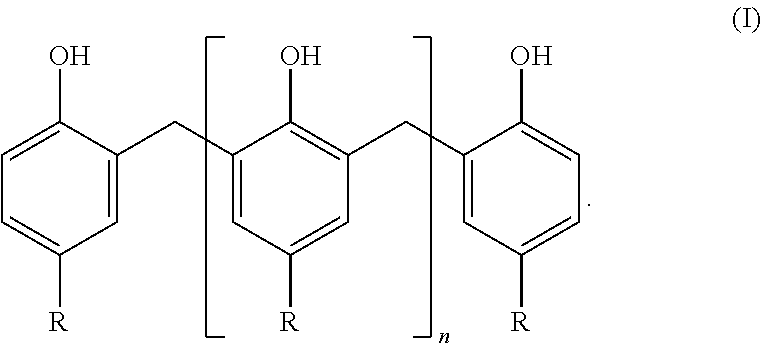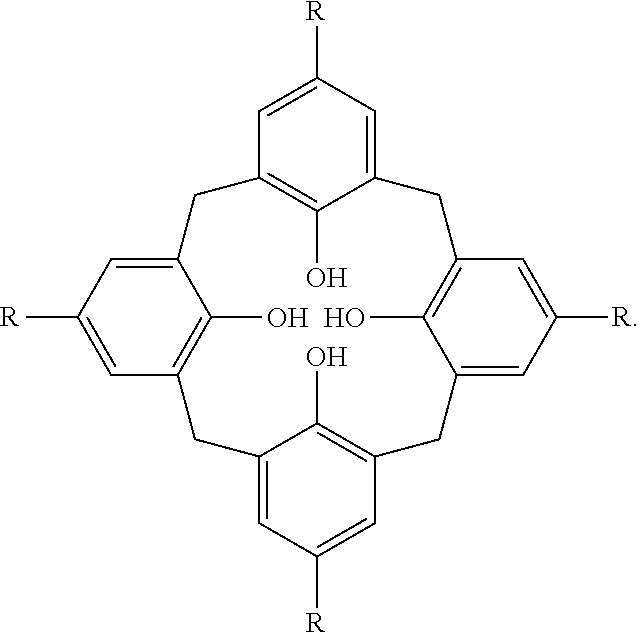Process for stabilizing phenolic resins containing calixarenes
a technology of phenolic resin and calixarene, which is applied in the direction of dewatering/demulsification using chemical means, etc., can solve the problems of inability to be processed further, insoluble insoluble insoluble insoluble insoluble insoluble insoluble insoluble insoluble insoluble insoluble insoluble insoluble insoluble insoluble insoluble insoluble insoluble insoluble insoluble insoluble insoluble insoluble insoluble insoluble insoluble insoluble insoluble insoluble insoluble insoluble insoluble insoluble insoluble insoluble insoluble insoluble insoluble insoluble insoluble in
- Summary
- Abstract
- Description
- Claims
- Application Information
AI Technical Summary
Benefits of technology
Problems solved by technology
Method used
Image
Examples
example 1
Synthesis of a Mixture of Calixarene / Linear Alkylphenolic Resins (Resin A)
[0054]A reaction vessel was charged with para-butylphenol and para-nonylphenol, Solvesso™ 150 solvent (an aromatic solvent), and sodium hydroxide. Formalin was added to the reaction mixture over a period of 0.5 to 1.5 hours. The reaction mixture was then heated to reflux and the reaction was completed within 3-4 hours, Solvesso™ 150 solvent was added to the reaction mixture to adjust the percentage of the resulting resins to 53-55 wt %. During the reaction, the product started to precipitate out of the resin solution. The final yield was 97%, and the appearance of the product was a suspension of partially insoluble material.
[0055]Samples of the final product were left under room temperature, and placed in the freezer at −25° C. for 24 hours. The insoluble solid precipitate was isolated and weighted.
example 2
Synthesis of a Mixture of Calixarene / Linear Alkylphenolic Resins (Resin B)
[0056]A reaction vessel was charged with para-tert-butylphenol, Solvesso™ 150 solvent, and sodium hydroxide. Formalin was added to the reaction mixture over 0.5-1.5 hours. The reaction mixture was then heated to reflux. Once the reaction was complete, and the reaction was completed within 3-4 hours, Solvesso™ 150 solvent was added to the reaction mixture to adjust the percentage of the resulting resins to 53-55%. During the reaction, the product started to precipitate out of the resin solution. The final yield was 97%, and the appearance of the product was a suspension of partially insoluble material.
[0057]Samples of the final product were left under room temperature, and placed in the freezer at −25° C. for 24 hours. The insoluble solid precipitate was isolated and weighted.
example 3
Reaction of Calixarene / Linear Alkylphenolic Resins with Propylene Carbonate
[0058]A reaction vessel was charged with Resin A of Example 1, which is a mixture of calixarene / linear resin of para-nonylphenol and para-butylphenol in Solvesso™ 150 solvent (containing 53-55% resulting resins), as shown in the synthetic procedures in Example 1. Resin A was added to the reaction vessel immediately after the reaction in Example 1 was complete, without storage under room temperature or at −25° C. The reaction vessel was heated to 130-140° C. Potassium carbonate was then added. The reaction mixture was stirred and the reaction temperature of the mixture was increased to 170-180° C. Once the reaction temperature reached 170-180° C., propylene carbonate was added slowly. After 3 hours, the reaction was complete.
[0059]Samples of the final product from each reaction were left under room temperature, and placed in the freezer at −25° C. for 24 hours. The insoluble solid precipitate was isolated and ...
PUM
| Property | Measurement | Unit |
|---|---|---|
| Fraction | aaaaa | aaaaa |
| Fraction | aaaaa | aaaaa |
| Fraction | aaaaa | aaaaa |
Abstract
Description
Claims
Application Information
 Login to View More
Login to View More - R&D
- Intellectual Property
- Life Sciences
- Materials
- Tech Scout
- Unparalleled Data Quality
- Higher Quality Content
- 60% Fewer Hallucinations
Browse by: Latest US Patents, China's latest patents, Technical Efficacy Thesaurus, Application Domain, Technology Topic, Popular Technical Reports.
© 2025 PatSnap. All rights reserved.Legal|Privacy policy|Modern Slavery Act Transparency Statement|Sitemap|About US| Contact US: help@patsnap.com



